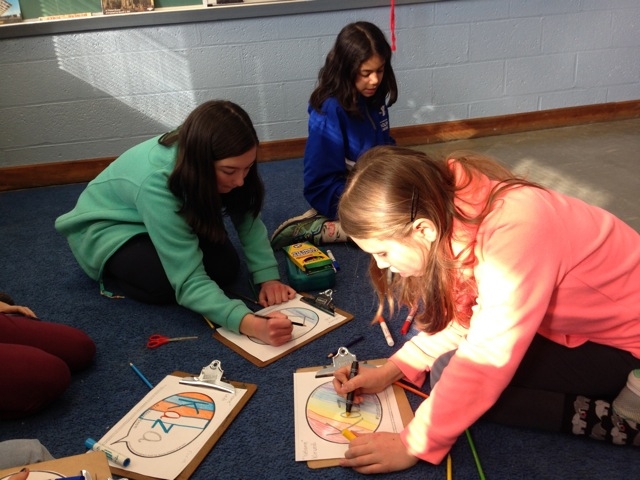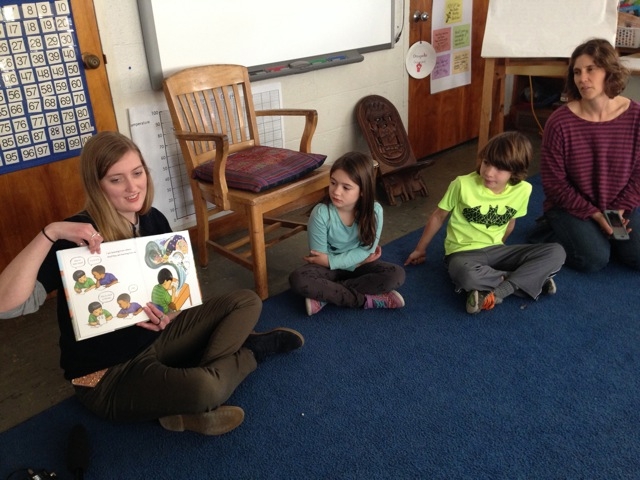When the city of Northampton decided more than a year ago to welcome refugees to their community, many groups engaged in the planning process — including the public schools. And despite President Trump’s attempt to suspend the refugee program, school children continue to prepare.
RELATED: After Preparing To Welcome Refugees, Northampton Now Waits
Some children at Jackson Street School and JFK Middle School are collecting socks, soap, toothpaste and toothbrushes to help the refugees settle in a new home.
And at Leeds Elementary, Alexandra Roche is helping children think about ways to make the refugees feel at home.

“This word is ‘welcome’ in Kirundi, and it’s ‘kaza,'” Roche told some students last week, teaching them a word in Kirundi, a language spoken in Burundi, where some of the refugees slated for Northampton would come from.
Roche is a volunteer with AmeriCorps VISTA. She’s working with Catholic Charities, which will help the refugees get settled. Roche is leading more than a dozen workshops in Western Massachusetts to help children understand what it’s like to be new. She starts by reading a book called “I’m New Here” by Anne Sibley O’Brien. The main characters come to the U.S. from other countries.
“’Back home I knew the language. My friends and I talked all day long,'” she read. “‘Here there are new words. I can’t understand them. The sounds are strange to my ears…”

Roche asked the children to reflect on their own experiences of being new and to draw pictures about it.
“I drew a girl that looks very nervous, because when I go to a new place I feel very nervous,” said Ally Britain, a third grader.
“When I first came here for first grade, I was very scared. I got here. I was like, ‘ooo,’” remembered Jack Corey — also in the third grade.
Roche asked the students what they can do to help newcomers feel a part of the school. Levi Hammerlund and Ellie Chambers have some ideas.
“You can, like, invite them to play like basketball or something at recess,” Levi suggested.
“You could ask if they wanted to sit next to you at lunch,” said Ellie.

Fifth grader Ava Medaugh wanted to know the best way to greet the refugees when they first arrive.
“Should we throw a party? Like, ‘Yay! Welcome!’ Or just like show them around?” Ava asked.
“Good question!” Roche said. “So the people coming are all different from each other, just as we are all different from each other here. Some people when they get here will be open to parties. Some people will be more quiet and nervous and unsure. We are going to try to feel it out when they arrive.”
Since Trump’s executive order — and legal action against it — it’s not known when the refugees will arrive. But the superintendent in Northampton, John Provost, said the school district is “still committed” to helping them resettle. And he has ideas for making the parents feel a part of the schools.
“Such as providing interpretation for meetings and making sure that all communications are understandable to the parents,” Provost said. “But I think there’s something that goes beyond technique here, which is spirit. We want to have a district where all parents and all students feel welcome.”
The children are more than ready.
“Like, is there a possibility that they’ll come to our school?” asked 5th grader Noah Daube-Valois, who has some understanding of what’s going on beyond Northampton. “It’s been a little bit…hard because of some things that have happened around the world and, like, the new laws that have been made.”
As the third graders get ready to go home for the day their teacher, Laura Ginsberg-Peltz, led them in singing goodbye in the languages of their families.
In Danish.
“Farvel, farvel…”
In Portuguese.
“Tchau, tchau, meus amigos, tchau, tchau…”
If children who are refugees do settle here, these children can’t wait to add new languages to their repertoire and new friends to their school.
Updated at 11:45 a.m. on Feb. 6, 2017, to identify which schools are collecting donated items.
